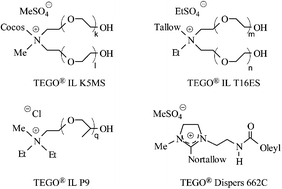Industrial application of ionic liquids as performance additives†
Abstract
Over the last decade

* Corresponding authors
a
Degussa AG, Goldschmidtstr. 100, 45127 Essen, Germany
E-mail:
bernd.weyershausen@degussa.com
Fax: +49-201-173 1839
Tel: +49-201-173 1655
b
Tego Chemie Service GmbH, Goldschmidtstr. 100, 45127 Essen, Germany
E-mail:
kathrin.lehmann@degussa.com
Fax: +49-201-173 3534
Tel: +49-201-173 2824
Over the last decade

 Please wait while we load your content...
Something went wrong. Try again?
Please wait while we load your content...
Something went wrong. Try again?
B. Weyershausen and K. Lehmann, Green Chem., 2005, 7, 15 DOI: 10.1039/B411357H
To request permission to reproduce material from this article, please go to the Copyright Clearance Center request page.
If you are an author contributing to an RSC publication, you do not need to request permission provided correct acknowledgement is given.
If you are the author of this article, you do not need to request permission to reproduce figures and diagrams provided correct acknowledgement is given. If you want to reproduce the whole article in a third-party publication (excluding your thesis/dissertation for which permission is not required) please go to the Copyright Clearance Center request page.
Read more about how to correctly acknowledge RSC content.
 Fetching data from CrossRef.
Fetching data from CrossRef.
This may take some time to load.
Loading related content
